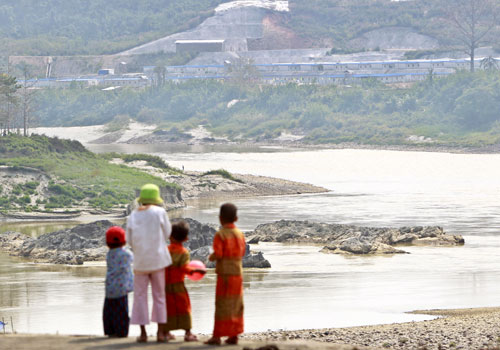Overcoming Myanmar's Myitsone Dam conundrum
china.org.cn / chinagate.cn by Dan Steinbock, April 29, 2016 Adjust font size:
|
|
|
Children look at the Myitsone dam from the bank of Ayeyarwady River in 2012. |
In 2009, after years of talks, most of the $3.6 billion Myitsone Dam project was to be paid for by the China Power Investment Corp. in a joint venture with Myanmar's Ministry of Electric Power. Myanmar was expected to get 10 percent of the electricity garnered, own the project after a 50-year period and earn $54 billion via tax payment, power and shares.
But criticism quickly ensued. Economically and socially, initial estimates were criticized for their underestimation of adverse impacts. Historically, the Irrawaddy is seen as the birthplace of Myanmar's civilization. Geopolitically, the dam is located in the unstable northern Kachin region, where clashes between the government and local separatists remain common. Internationally, foreign governments, including the U.S. embassy, have funded some anti-dam activists, as disclosed by Wikileaks.
In fall 2011, then-president Thein Sein suspended the project. Recently, Aung San Suu Kyi, the leader of the National League for Democracy (NLD), won a huge parliamentary majority. What will the new government do?
Myanmar's long emergence
In China, observers believe the dam project was stopped and the Chinese companies targeted unfairly. But although China has been portrayed as the exclusive partner of the old military government, Japan provided the country with $2.2 billion in foreign aid and reparations until the 1990s.
The close relations were due to General Ne Win, who had been trained by the Japanese in 1940. While half of Myanmar's foreign aid came from Tokyo, Ne Win's widespread persecution of ethnic Chinese moved from discrimination to mass violence. After the 1988 military coup, General Saw Maung took over but Ne Win remained influential in the military into the 1990s. This long "inconvenient history" is often downplayed in the West.
As the new military rulers consolidated power, Japan became preoccupied by its own economic troubles. It was then that Chinese firms filled the vacuum investing in hydropower dams, mining projects, oil and gas.
By the early 2010s, Myanmar's reforms had led Washington to relax curbs on foreign aid to Myanmar, relations were normalized and Brussels followed suit. As Western investment drives took off, some late entrants began to compete for projects that China had already been scheduled to manage.
Need for cooperation
After the recent visit by Foreign Minister Wang Yi, Suu Kyi said she had not read the contract for the Myitsone project but characterized bilateral relations with China as "very important politically, as well as socially and economically."
In the past five years, Myanmar has tripled its expenditure on electricity. Yet, only one third of the country's 53 million people live with electricity. Today, two-thirds of total electricity comes from hydropower, 29 percent from gas, and less than 1 percent from wind, solar and biomass. Full access will take until 2030.
While most people in Myanmar would prefer uncontroversial electricity resources, all expect accelerated development. Unlike the U.S., China is a large investor in Myanmar. In turn, Chinese firms have learned lessons of their own about local responsiveness and community relations.
Indeed, there is reason for cautious optimism. While Aung San Suu Kyi cannot ignore the legal weight of contracts, she has the mandate to come up with out-of-the box solutions, which could prove to be pragmatic and balanced. In another contested case - the Chinese-Myanmar Letpadaung copper mine - she did not recommend project cancellation but revised terms instead. This allowed construction while reducing adverse impact locally.
Myanmar has a great interest in China's development experience and pioneering efforts, including the "Belt and Road" initiative, the Asian Infrastructure Investment Bank and the NewBRICS Development Bank.
Historically, China and Myanmar have gained a lot from sustained economic cooperation. Today, the need for mutual collaboration is greater than ever before.
Dr Dan Steinbock is Guest Fellow of Shanghai Institutes for International Studies (SIIS). This commentary is based on his project on "China and the multipolar world economy" at SIIS, a leading global think-tank in China. For more about SIIS, see http://en.siis.org.cn/ ; about Dr Steinbock, see http://www.differencegroup.net/
Opinion articles reflect the views of their authors only, not necessarily those of China.org.cn.
